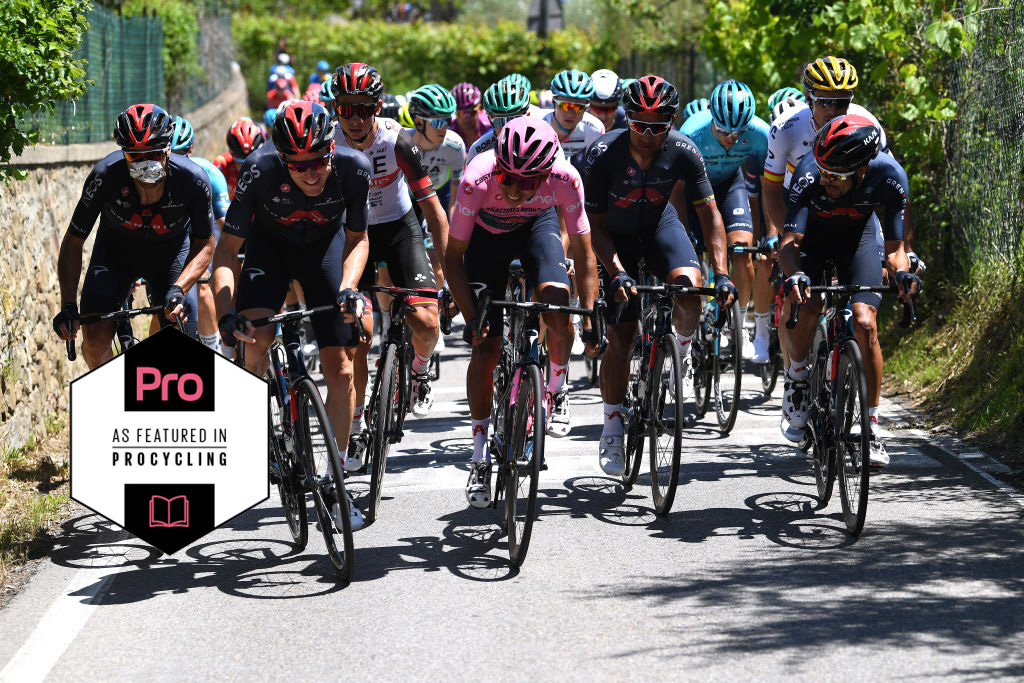Giro d'Italia stage 14 analysis: Ineos domination
So far Bernal looks better than he did when he won the Tour de France in 2019

If it wasn’t already obvious that Egan Bernal was the rider to beat in the 2021 Giro d'Italia, the Colombian reinforced his position long before the slopes of the Monte Zoncolan on stage 14 of the race. On the descent of the Forcella di Monte Rest, with 48km to go, when Astana pushed the pace at the front on the downhill they split the peloton for a period, and it was Bernal and his teammate Jonathan Castroviejo who latched onto the back of the seven rider group. For seven kilometres, the four Astana riders, including Aleksandr Vlasov, were tailed by the Ineos Grenadiers duo, and Bahrain Victorious rider Pello Bilbao, and held a gap of around 15 seconds over the rest behind.
Ultimately, the move came to nothing, and the peloton regrouped in the valley before the climb up the Zoncolan. But it was telling that Bernal was the only GC contender who reacted instantly to the danger the Kazakh team posed. And even though the gap was never that sizeable, other teams such as Deceuninck-QuickStep and EF Education-Nippo were still forced to chase to close it down, burning up teammates before the Zoncolan had even reared into view. Bernal, as well as his Ineos teammates, could sit in, save energy and enjoy the ride.
To win a Grand Tour, a rider obviously needs to be physically strong - and Bernal’s devastating attack later on the Zoncolan, to finish fourth on the stage and put even more time into his rivals, further proved he is the strongest in the race. Yet riders also need to not lose time if they’re going to win a Grand Tour, as well as gain it. And at every crucial moment in this year’s Giro so far, Bernal has been positioned in the right place at the right time. He’s riding exactly how a Grand Tour winner should, and not just because he’s gaining time in the mountains.
During the first two weeks of this year’s Giro, Bernal has been at the front of the peloton throughout, even when he wasn’t wearing the pink jersey. He’s never been caught out of position, never been slow to react, and has seen opportunity after opportunity to gain time - the acceleration on the descent was a sign of a rider with sharp instincts, in mentally as well as physically the best form. Compare this to the 2020 Tour de France, where Bernal rode within the peloton and sat behind the Jumbo-Visma train, following the moves of other riders rather than instigating them himself. His demeanor on the bike couldn’t have been more different.
A lot of the credit goes to the strength of the Ineos team around the Colombian who have never yet left him isolated and look back to being the dominating, superior Grand Tour team after last year’s Tour blip. On the sprint stages, Filippo Ganna has been shepherding Bernal right to the front, lining up shoulder to shoulder with the sprinter trains. The duo even dared to contest the intermediate sprint on stage 10, forcing Remco Evenepoel into action, too. On the Strade Bianche gravel, it was the Italian again who drove the pace on the front with Bernal glued to his back wheel, splitting the peloton to pieces behind. Then in the mountains, the infamous Ineos train has been the one taking control and setting the pace, with Gianni Moscon, Castroviejo, Jhonatan Navaez, and Dani Martínez all in place every time the road rears upwards.
It’s telling that on each of the three mountain top finishes so far (stages 6, 9 and 14), Ineos have been the only team to have two riders into the top 10 each time - Bernal and compatriot Martínez. Martínez now sits in ninth overall, 3:54 behind Bernal. Strength in depth has always been the Ineos modus operandi, but in 2021 (if it’s even possible) the team looks more all-conquering than ever. They’ve won three stage races, placing a second rider on the podium in every one, and finished on the podium in a further three and it's a pattern that so far is continuing in Italy.
There’s still a week to go in the Giro, of course, and Bernal has far from got the pink jersey victory sewn up and confirmed. But on the evidence of the first 14 stages, the 24-year-old, so far, looks better than he did when he won the Tour title in 2019.
Get The Leadout Newsletter
The latest race content, interviews, features, reviews and expert buying guides, direct to your inbox!
Sophie Hurcom is the deputy editor of Procycling magazine.
Procycling magazine: the best writing and photography from inside the world's toughest sport. Pick up your copy now in all good newsagents and supermarkets, or get a Procycling subscription.
Sophie Hurcom is Procycling’s deputy editor. She joined the magazine in 2017, after working at Cycling Weekly where she started on work experience before becoming a sub editor, and then news and features writer. Prior to that, she graduated from City University London with a Masters degree in magazine journalism. Sophie has since reported from races all over the world, including multiple Tours de France, where she was thrown in at the deep end by making her race debut in 2014 on the stage that Chris Froome crashed out on the Roubaix cobbles.